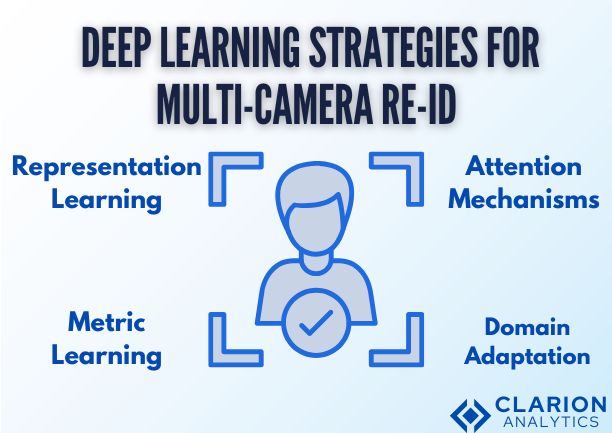
Introduction
Modern surveillance systems together with smart city and security measures heavily rely on Multi-Camera Person Re-Identification (Re-ID) technology for their operations. The technology allows the identification of one person across various camera feeds even with appearance or lighting or background changes between different streams. AI-based methods need to replace handcrafted feature-based methods since these approaches cannot produce satisfactory outcomes under existing conditions.
The biggest challenge in multi-camera Re-ID happens when cameras capture individuals who differ in view and illumination and encounter obstruction or display resolution changes. The combination of state-of-the-art feature extraction with metric learning in deep learning-based Re-ID systems allows them to resolve these problems.
This blog discusses the main issues of multi-camera Re-ID along with efficient deep learning techniques and performance-enhancing optimizations that function for real-world scenarios. Surveillance systems become more secure through the implementation of AI-based solutions while acquiring the ability to deploy security and monitoring effectively at scale.
Image Credit
1. Key Challenges in Multi-Camera Person Re-ID
A camera’s multiple snapshots show a single individual differently because the person expressions the appearance in varying ways through clothing choice and body posture and partial or complete picture blockages. Persons can change clothing and positions and classical feature-matching can no longer be effective.
The outdoor environment affects image quality because sunlight and shadows as well as man-made light affect different cameras under different lighting conditions. Advanced vision is hindered through rainy conditions together with fog since these elements reduce the identification clarity.
Surveillance cameras with low image resolutions primarily photograph subjects from great distances. The accuracy of Re-ID models decreases when feature extraction becomes challenging because of poor resolution which requires specialized super-resolution methods.
A person becomes difficult to identify when they are within backgrounds filled with too many objects together with several other people in the same space. During feature extraction the model needs strong enough capabilities to recognize the target person distinctly from distracting elements.
The implementation of Re-ID in substantial real-time surveillance programs creates computational problems that lead to implementation difficulties. System performance needs to be maintained through the implementation of effective indexing and retrieval techniques in order to handle large numbers of identities.
2. Effective Deep Learning Strategies for Multi-Camera Re-ID
Feature Representation Learning
Both ResNet and DenseNet under the Convolutional Neural Networks category have the capability to detect main features.
Vision Transformers (ViTs) among other Transformer models enhance the understanding of space and context thereby boosting Re-ID performance.
Metric Learning Approaches
The person embeddings obtain higher discriminatory qualities through the introduction of triplet loss and contrastive loss metric learning methods. The metric learning approach adjusts the position of similar individual elements closer toward one another while directing different identity elements toward distant positions.
Attention Mechanisms
The Transformer self-attention mechanism enables models to focus on identity distinct features instead of irrelevant data. The feature extraction abilities of part-based attention networks are achieved through their ability to process different body components.
Domain Adaptation & Transfer Learning
Using the large datasets Market-1501 and DukeMTMC-ReID for training models enables better performance in various operational conditions. Model modifications for surveillance environments enhance their precision which enables them to perform better in actual surveillance operations.
3. Optimizing Multi-Camera Re-ID with Advanced Techniques
3D pose estimation along with skeleton features make Re-ID models effective at maintaining person identification regardless of body posture changes. Identity information stays constant regardless of view changes in these representations.
Using Graph Neural Networks (GNNs) helps develop relational learning methods to demonstrate person identity associations between multiple cameras. The use of GNNs in matching security systems allows learning resilient relationships across multiple cameras for improved performance.
The technique uses Generative Adversarial Networks (GANs) to produce simulated data that properly extends training datasets. The model becomes more robust when supplied with diverse appearance distributions and different types of lighting environments.
Different information types can be integrated within Fusion Strategies to enhance Recognition-Through-Identification performance through the use of vision and motion together with biometric information. Three types of identification data including facial recognition along with gait analysis together with body shape information enhance the reliability of identification processes.
The deployment of Re-ID models on edge devices gives real-time execution and eliminates latency for performance speed-up. The implementation of Edge AI technology performs local inference tasks which decreases network bandwidth requirements to streamline big-scale Re-ID systems.
Are you intrigued by the possibilities of AI? Let’s chat! We’d love to answer your questions and show you how AI can transform your industry. Contact Us
